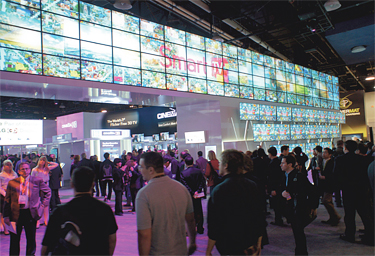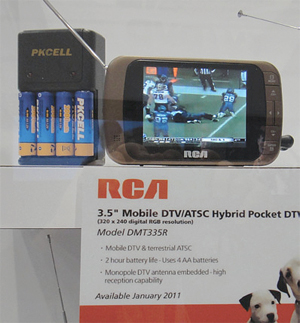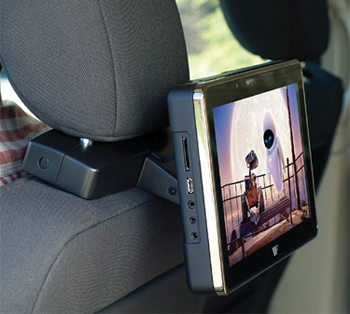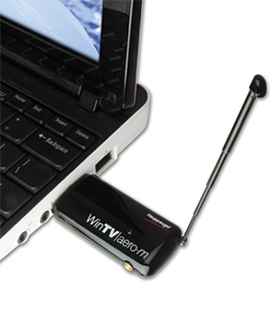CES Converges Net with TV
LAS VEGAS—Internet-connected TV sets were omnipresent at the 2011 International CES, bolstering the organization’s expectations that 30 million ’net-connected sets will be sold this year, and giving many attendees their first opportunity to look at products such as Google TV.

More than 140,000 packed the Las Vegas Convention Center and related locales for the 2011 International CES. Although Sony and Logitech introduced their devices—respectively a flat-panel TV set and the “Revue” set-top box—in October, several other Google TV licensees including LG, Sharp and Toshiba held back their models while Google revises its system. Subsequent reports indicate that Google will use a cheaper chip with its software, a decision which prompted the delay.
Separately, Syncbak Inc., a start-up funded in part by both NAB and CEA, demonstrated more details about its “over-the-top broadcast” technology that enables the delivery of broadcast TV and targeted ads to broadband devices. Syncbak uses about one percent of the broadcast spectrum to create a real-time connection between a broadcast station and viewers. Proprietary authentication software creates a closed transmission path to verify that the live broadcast content is distributed only to viewers entitled to see it, according to company CEO Jack Perry. Perry expects the first 50 to 100 Syncbak units will be in place at TV stations by April, in time for the NAB Show, although he has not yet identified the initial markets.
Although dozens of exhibitors showed their latest 3D TV equipment, the buzz was decidedly diminished from last year. Several approaches to “no glasses” 3D were on display, including prototypes from Sony, Toshiba and others, which offered a very narrow viewing area. Two start-ups attracted considerable attention: 3DFusion, a Dutch company that offers 2D to 3D conversion and other technology, demonstrated its system privately, while iPont, a Hungarian company showed a device to convert dual-channel 3D content for autostereoscopic viewing.
SPECTRUM SQUATTERS
Another airwaves assault, including revived “squatting” accusations aimed at broadcasters, added a dose of realpolitik to the often-surreal deluge of digital devices.
CEA President Gary Shapiro initiated the war of words during his welcoming remarks, charging that broadcasters “are squatting on our broadband future … [TV] spectrum needs to be repurposed and reused.” He said that, with a goal of freeing up 500 Megahertz of spectrum by 2020, CEA is urging Congress to “pass legislation allowing the FCC to conduct voluntary incentive auctions of broadcast spectrum.” Shapiro’s comments were part of his continuing “innovation” mantra, encouraging policies that will support technology development, the theme of his new book, “The Comeback.”
National Association of Broadcasters President Gordon Smith, attending CES in connection with meetings that involved NAB members, immediately refuted Shapiro’s contention.
“He simply sees a world of wireless broadband, and that’s just not what the future holds,” Smith told reporters. “When you talk about transmitting video, no industry does it more efficiently than broadcasting…‘squatting’ is a cute term, but it misses the future. People want video-on-demand, but they also want [TV] live.” Smith added that any view of “a broadband world to the exclusion of broadcasting simply misses the reality of what the future will eventually produce.”

Tivizen from South Korean company Valups, receives Mobile DTV signals for the iPad and iPhone and will go on sale in June for $99.

Digital Stream, licensee of the RCA brand, debuted four new hybrid handheld Mobile DTV/Off-Air receivers. The line of portable sets will be available in 3.5-inch and 7-inch versions and will cost between $109 and $169.
WashingtonPost.com has a two-minute clip of Smith’s comments.
Spectrum allocation was in the spotlight again on CES’s second day when FCC Chairman Julius Genachowski affirmed that the United States faces a “spectrum crunch” and emphasized that mobile broadband is critical to economic growth and global competitiveness.
“The consumer electronics industry is going wireless...we need to free up more spectrum,” Genachowski said, adding that releasing more mobile spectrum is the FCC’s “top priority” this year.
Following his formal remarks, Genachowski sat down for a brief on-stage dialog with Shapiro. The Chairman indicated that as soon as Congress approves broadcast spectrum reallocation, the commission would act quickly—possibly in less than two years—to establish a framework and develop auction rules.
MOBILE DTV CONFUSION
The flare-up between CEA and NAB, plus Genachowski’s comments, not only gave the 140,000 CES attendees (about 11 percent more than last year) something to debate. The brouhaha seemed to some attendees as counter-intuitive, given the focus on Mobile DTV at CES—a collaboration of broadcasters and electronics makers to introduce broadcast services via mobile handsets and other devices, including the new “tablet” category that was omnipresent at CES.
Yet even that cooperative approach was sullied. Manufacturers said they are confused about the roles of the two new broadcaster coalitions—the Mobile Content Venture and the Mobile 500 Alliance—that are developing content packages for Mobile DTV services. Executives associated with MCV and M500 told TV Technology that electronics makers perceive the two groups as rivals, failing to understand that MCV represents national broadcast networks and programmers (notably Fox and NBCUniversal) while Mobile 500 consists of more than 40 broadcast group owners and the hundreds of local stations they operate.
Both coalitions went to CES to expand their deals with mobile equipment makers but were flummoxed by the pushback from hardware companies, who are particularly concerned about multiple standards, according to sources familiar with the negotiations.
Adding to the confusion was a private presentation by Andrew Setos, President of Engineering for the Fox Entertainment Group. In discussions with tablet makers, Setos reportedly described a Fox plan for a dedicated app, according to sources. Electronics makers are loathe to install multiple apps to receive supposedly standardized content from broadcasters. Setos could not be reached to discuss Fox’s plan or exactly what he said during his Las Vegas meetings.
Despite these complications accompanying Mobile DTV’s presence at CES, the mobile TV industry unleashed several aggressive initiatives.
The Open Mobile Video Coalition, the broadcaster-centric association that is seeking to “accelerate the development of Mobile DTV,” spun off the “Mobile DTV Forum” as an organization for manufacturers of Mobile DTV equipment. Charter members include Dell, Harris, LG Electronics and Samsung, companies that had already been participating with OMVC field trials and technical tests.
Vince Sadusky, president of OMVC and president/CEO of LIN Media, called it “fitting” that the OMVC establish a separate group to focus on hardware development.
“By expanding our membership beyond broadcast companies, we hope to bring greater resources to the task of perfecting the mobile DTV consumer experience,” Sadusky said at a reception introducing the mDTV Forum.
Dr. Jong Kim, president of Zenith, LG Electronics’ U.S. research and development company, said that LG is “enthusiastic about collaborating with broadcasters on mobile viewing devices.”

Antenna maker Winegard debuted cioTV, the industry’s largest display for cars for receiving Mobile DTV.

Hauppauge’s WinTV-Aero-m is designed to watch live, over-the-air, digital TV on a PC-based laptop or netbook. It will have an MSRP of $69.
“Our society is becoming increasingly mobile, with consumers demanding access to the Internet at all times – plus ready access to news and information that can be most efficiently transmitted and received by millions of people through the medium of broadcasting,” Kim told TV Technology.
At a Mobile DTV “TechZone” on the CES show floor, a dozen companies—mostly U.S. and Korean manufacturers—showed a variety receivers and peripherals, including Valups dongles to enable iPads and iPhones to receive Mobile DTV signals. LG presented a no-glasses 3D tablet and handset and iMovee introduced a new Mobeo pocket Wi-Fi receiver for Mobile DTV.
OMVC released findings (PDF) of its 2010 “Consumer Showcase” which involved 345 users in the Washington, DC, area. The standout result was that “daytime is primetime.” The highest level of Mobile DTV viewing occurred in the noon to 3 p.m. period. The study identified distinctly different usage of the Samsung phone handset and Dell netbook used in the field trial: at home, 85 percent of the viewing was done on the netbook compared to 28 percent on the handset. At “work/school,” 53 percent of viewing was on the handset versus 14 percent on netbooks.
The RCA brand, making its return to CES under new overseas ownership, included dedicated mobile receivers in its line-up. RCA says its battery-operated portable sets—ranging from 3.5 to 7 inches in screen size—are the first devices to provide both standard and mobile DTV signals.
ION Media Networks said it will upgrade stations in 10 markets for transmitting Mobile DTV signals prior to March.
The professional video industry's #1 source for news, trends and product and tech information. Sign up below.
Gary Arlen, a contributor to Broadcasting & Cable, NextTV and TV Tech, is known for his visionary insights into the convergence of media + telecom + content + technology. His perspectives on public/tech policy, marketing and audience measurement have added to the value of his research and analyses of emerging interactive and broadband services. Gary was founder/editor/publisher of Interactivity Report, TeleServices Report and other influential newsletters; he was the long-time “curmudgeon” columnist for Multichannel News as well as a regular contributor to AdMap, Washington Technology and Telecommunications Reports; Gary writes regularly about trends and media/marketing for the Consumer Technology Association's i3 magazine plus several blogs.

